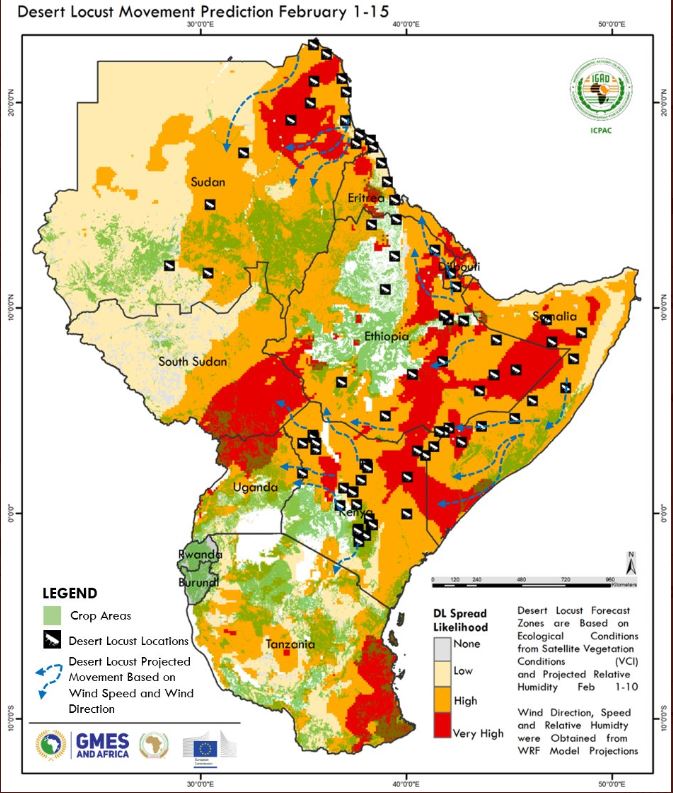
Status Update and Public Advisory regarding Desert Locust Invasion
Kampala, 18th February 2020. Hon. Bright Rwamirama the Minister of State for Animal Industry has addressed the media at the Uganda Media Centre alongside Mr. Antonio Querido the Country Representative for the Food and Agriculture Organisation of the United Nations (FAO) today.
Below is an excerpt of the status report.
Status of the Desert Locust Invasion in Uganda:
- Swarms of Locusts entered Uganda On February 9th, 2020 through Amudat and have now been sighted in 8 districts; Abim, Kabong, Nakapiripirit, Amudat, Agago, Kole, Katakwi, Nabilatuk and there are reports of sightings in Lango, Acholi and West Nile sub-regions. The existing swarms have now been classified as mature locusts that may not have much longer to live after laying eggs
- The swarms of locusts in Uganda continue to spread to other districts in the region and laying of eggs is expected to continue while other locust swarms are still invading Uganda from neighboring Kenya. It is worth noting that a female locust lays at least 300 eggs in one sitting and will lay eggs three times in its lifecycle. The nymphs and young Desert Locusts (mainly pink in colour) that will come after the first hatching are the most dangerous since they have high need for food.
- The existing swarms have not caused significant damage to our vegetation cover, however, there is an eminent threat to food security following a possible outbreak.
- The eminent threat caused by the locust invasion is to Food Security. Locusts are herbivorous and feed on green vegetation. This means that whereas human beings and animals may be safe, the crops and grasslands on the other hand are at risk and so is everything depending on them for their livelihoods. This is largely because a locust swarm feeds on 100-160 tons of vegetation per day
- Uganda has two major cropping seasons – March-June (Season A) and Sep-Dec (Season B) and this particular invasion is just after the last harvest and before the first cropping season. In the affected areas, vegetation, crops, grasslands and grain are vulnerable. The crops include; sorghum, cassava, sweet potato, maize and millet.
- The locust swarms have been laying eggs and should these eggs hatch, Uganda may be faced with an Outbreak. As a mitigation measure, Government of Uganda through the Ministry of Agriculture has adopted the following measures:
- Coordination of relevant stakeholders from the respective Ministries, Departments and Agencies, Development Partners and all other stakeholders.
- Enhanced Surveillance:
- Surveillance teams working hand in hand with the support of the UPDF in the region are assessing the travelling patterns of the first swarm to construct maps of sites where the eggs have been laid
- This will enable the technical staff to survey and monitor the hotspots for any locust invasion.
- While the spraying of the adult Desert Locusts is being carried out, these surveillance maps will be used to provide coordinates for the aircraft that will be used in the aerial spraying of the nymphs and immature locusts that will be hatched into the region in less than 2 weeks.
- Procurement of appropriate equipment: Leasing of aerial spraying aircraft has been finalized, Pesticides, Protective gear, motorized pumps and knapsacks sprays have been procured and dispatched to the affected areas
- Resource mobilization: Government has mobilized resources from its treasury and various Development Partners to facilitate its Desert Locust Control Plan and this is how it has been spent so far:
- Total Received: Ugx 22 Bn
Allocation:
- 11.1 BN – Desert Locust Control Organization;
- 3.6BN for Aircrafts leasing,
- 0.3BN for UPDF Operations
- 7BN – Chemicals, Logistics, Protective Gear, Pumps, Surveillance
- Sensitization and Awareness creation across different audiences: Through various community sensitization exercises, media interactions, policy maker engagements, public awareness on Desert Locusts has been heightened
- Strengthening partnerships with development partners within the region: Uganda now has three Desert Locust Experts to backstop the Desert Locust Control activities
- Capacity Building:
- Capacity Building of Trainers of Trainers of 60 Technical staff who have in turn conducted; continuous training of extension officers on identification, reporting and response when locusts are sighted
- 1000 UPDF Officers have been trained on ground spraying and the exercise is still ongoing
- The supporting experts from the Food and Agriculture Organisation of the United Nations, the Desert Locust Control Organisation and National Agricultural Research Organisation are still in the region undertaking refresher training of extension workers and surveillance teams from the Ministry of Agriculture and Districts in the region
- While some of the teams in the area may have been seen burning bushes and chasing the adult Desert Locusts, awareness creation teams from the District and Ministry of Agriculture have been expanded and are now reaching more people with the following sets of information:
- the burning of bushes is hazardous to the environment in the area
- chasing the adult Desert Locusts can make it more difficult for the Control Teams to fight them in massive swarms since they can easily separate into more swarms. This makes all means, including aerial spraying more difficult.
- The two aircrafts for aerial spraying will be in the country before the first hatching and will be loaded with the pesticide needed in the control of the Desert Locusts.
Desert Locust Invasion Update: Below is a map of the invasion in Africa as completed by the Intergovernmental Authority on Development (IGAD) Climate Prediction and Applications Centre.
The general public is advised to ignore mixed reports aimed at reducing the ability of Ugandans to fight the invasion and expose the economy to great risk.

The Ministry of Agriculture Animal Industry and Fisheries remains committed to providing the relevant advisories and progress reports to the public to maintain vigilance and resilience.
The Ministry of Agriculture Animal Industry and Fisheries pledges to keep the nation updated on the developments and progress made in the effort to avert a potential food crisis in the Country.
Notes for editors
About the Ministry of Agriculture, Animal Industry and Fisheries (MAAIF)
The Ministry of Agriculture, Animal Industry and Fisheries is a Ministry in the Government of Uganda charged with creating an enabling environment in the Agricultural Sector.
The Ministry formulates, reviews and implement national policies, plans, strategies, regulations and standards and enforce laws, regulations and standards along the value chain of crops, livestock and fisheries.
Vision: A competitive, profitable and sustainable agricultural sector.
Mission: To transform subsistence farming to commercial agriculture.
Strategic Objectives
- To initiate the formulation and review of the policy and legal framework for the sector
- To establish and implement systems for service provision in the sector
- To strengthen and implement strategies, regulatory framework, standards, institutional structures and infrastructure for quality assurance and increased quantities of agricultural products to access and sustain local, regional and export markets
- To design and implement sustainable capacity building programmes for stakeholders in the agricultural sector through training, re-tooling, infrastructure, provision of logistics and ICT
- To develop strategies for sustainable food security
- To develop appropriate agricultural technologies for improved agricultural production, productivity and value addition through research
- To develop effective collaborative mechanisms with affiliated institutions and
- To take lead and establish a system and institutional framework for agricultural data collection, analyses, storage and dissemination to stakeholders including Uganda Bureau of Statistics.
The Ministry of Agriculture, Animal Industry and Fisheries (MAAIF) is made up of four Directorates including the Directorate of Crop Resources, Directorate of Animal Resources, Directorate of Agricultural Extension Services and the Directorate of Fisheries Resources each with Departments, Divisions and Partnership Projects.
The Departments of the Ministry which do not fall directly in the above include the Department of Agricultural Planning and Development, the Human Resource Department, the Department of Finance and Administration and the Department of Agricultural Infrastructure, Mechanisation and Water for Agricultural Production.
The Ministry is also made up of seven Agencies including the National Agricultural Research Organisation (NARO), the National Agricultural Advisory Services (NAADS), Cotton Development Organisation (CDO), Dairy Development Authority (DDA), Uganda Coffee Development Authority (UCDA) and Coordinating Office for the Control of Trypanosomiasis in Uganda (COCTU) and the National Animal Genetic Resources Centre and Databank (NAGRC&DB).
